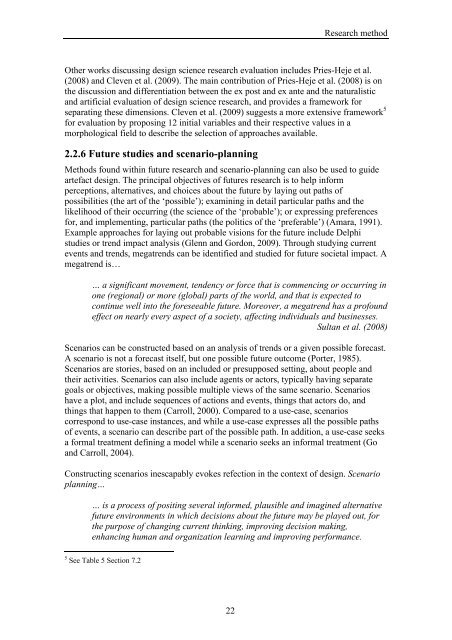Multi-channel provisioning of public services - Department of ...
Multi-channel provisioning of public services - Department of ...
Multi-channel provisioning of public services - Department of ...
You also want an ePaper? Increase the reach of your titles
YUMPU automatically turns print PDFs into web optimized ePapers that Google loves.
Research method<br />
Other works discussing design science research evaluation includes Pries-Heje et al.<br />
(2008) and Cleven et al. (2009). The main contribution <strong>of</strong> Pries-Heje et al. (2008) is on<br />
the discussion and differentiation between the ex post and ex ante and the naturalistic<br />
and artificial evaluation <strong>of</strong> design science research, and provides a framework for<br />
separating these dimensions. Cleven et al. (2009) suggests a more extensive framework 5<br />
for evaluation by proposing 12 initial variables and their respective values in a<br />
morphological field to describe the selection <strong>of</strong> approaches available.<br />
2.2.6 Future studies and scenario-planning<br />
Methods found within future research and scenario-planning can also be used to guide<br />
artefact design. The principal objectives <strong>of</strong> futures research is to help inform<br />
perceptions, alternatives, and choices about the future by laying out paths <strong>of</strong><br />
possibilities (the art <strong>of</strong> the ‘possible’); examining in detail particular paths and the<br />
likelihood <strong>of</strong> their occurring (the science <strong>of</strong> the ‘probable’); or expressing preferences<br />
for, and implementing, particular paths (the politics <strong>of</strong> the ‘preferable’) (Amara, 1991).<br />
Example approaches for laying out probable visions for the future include Delphi<br />
studies or trend impact analysis (Glenn and Gordon, 2009). Through studying current<br />
events and trends, megatrends can be identified and studied for future societal impact. A<br />
megatrend is…<br />
… a significant movement, tendency or force that is commencing or occurring in<br />
one (regional) or more (global) parts <strong>of</strong> the world, and that is expected to<br />
continue well into the foreseeable future. Moreover, a megatrend has a pr<strong>of</strong>ound<br />
effect on nearly every aspect <strong>of</strong> a society, affecting individuals and businesses.<br />
Sultan et al. (2008)<br />
Scenarios can be constructed based on an analysis <strong>of</strong> trends or a given possible forecast.<br />
A scenario is not a forecast itself, but one possible future outcome (Porter, 1985).<br />
Scenarios are stories, based on an included or presupposed setting, about people and<br />
their activities. Scenarios can also include agents or actors, typically having separate<br />
goals or objectives, making possible multiple views <strong>of</strong> the same scenario. Scenarios<br />
have a plot, and include sequences <strong>of</strong> actions and events, things that actors do, and<br />
things that happen to them (Carroll, 2000). Compared to a use-case, scenarios<br />
correspond to use-case instances, and while a use-case expresses all the possible paths<br />
<strong>of</strong> events, a scenario can describe part <strong>of</strong> the possible path. In addition, a use-case seeks<br />
a formal treatment defining a model while a scenario seeks an informal treatment (Go<br />
and Carroll, 2004).<br />
Constructing scenarios inescapably evokes refection in the context <strong>of</strong> design. Scenario<br />
planning…<br />
… is a process <strong>of</strong> positing several informed, plausible and imagined alternative<br />
future environments in which decisions about the future may be played out, for<br />
the purpose <strong>of</strong> changing current thinking, improving decision making,<br />
enhancing human and organization learning and improving performance.<br />
5 See Table 5 Section 7.2<br />
22
















